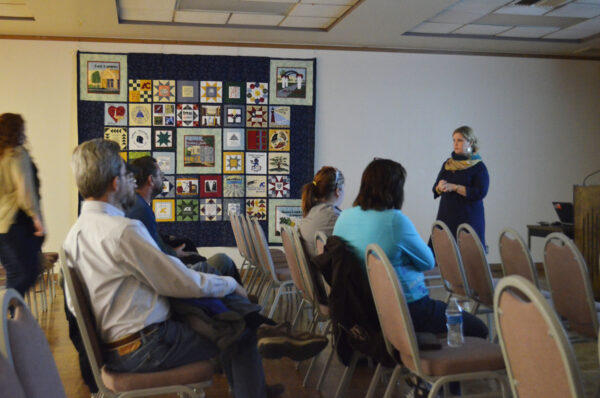
Photo by PERLA ARELLANO | The Ranger
Brianna Burnett, a visiting photographer, speaks to Amarillo College faculty and students April 3 on the Washington Street Campus.
Brianna Burnett didn’t start out as a photographer. As a student at Austin College, she began her studies as an undergraduate pre-law major. She eventually switched her major and earned a master’s degree in photography at Texas Tech University.
“I didn’t understand that art was something you can do,” she said.
On April 3, Burnett, spoke to Amarillo College faculty and students on the Washington Street Campus about her work in photography and a process she uses called “dry tintype.”
Wet plate is the traditional process for making a tintype, a photo printed on metal instead of paper or other media. Dry plate is the contemporary method and is less toxic, Burnett said.
Unlike wet plate, where time is limited, dry plates can be prepped ahead of time, she said. Burnett said that because she lacked confidence in the beginning, she would start out with small two-inch by two-inch prints.
“If I make them tiny and mess up, it doesn’t really count,” she said she’d tell herself.
It wasn’t until her knowledge and confidence grew that she started to use larger prints up to 18-inches by 18-inches, she said.
Tintypes aren’t the only photos Burnett has created. She started working on documentary photography and also worked as a newspaper photographer in Kathmandu, Nepal, but she said it was difficult for her to “force herself” into other people’s privacy.
“Photography for me wasn’t documentary.” Burnett said. “It has always been storytelling.”
Telling stories is a big theme in her work, she said. She also has experimented with the titles of her work as a process for storytelling. The first pieces of work she created were personal narratives and experiences, but it evolved to also include stories from mythology, she said.
“Each kind of series had its own kind of genre of story,” Burnett said. “They are all based off narratives.”
Natasha Thorn, a photography major, said she liked learning about what inspired Burnett and the process she went through.
“You always have to find something that is going to inspire and make you want to work harder,” Thorn said.
Esther Perkins, another photography major, agreed with Thorn and said she also liked the process of how Burnett came up with her ideas to create images. Perkins said coming up with ideas is one of the hardest things.
“I liked how she figured out that she wasn’t a documentary photographer; that she had to do different things to figure out what she was the best at,” Perkins said.
It’s a lesson the students, like others, said they learn as they make their way through college.
“We’re trying out different things to see what we want to do when we get done,”’ Thorn said.

Leave a Reply